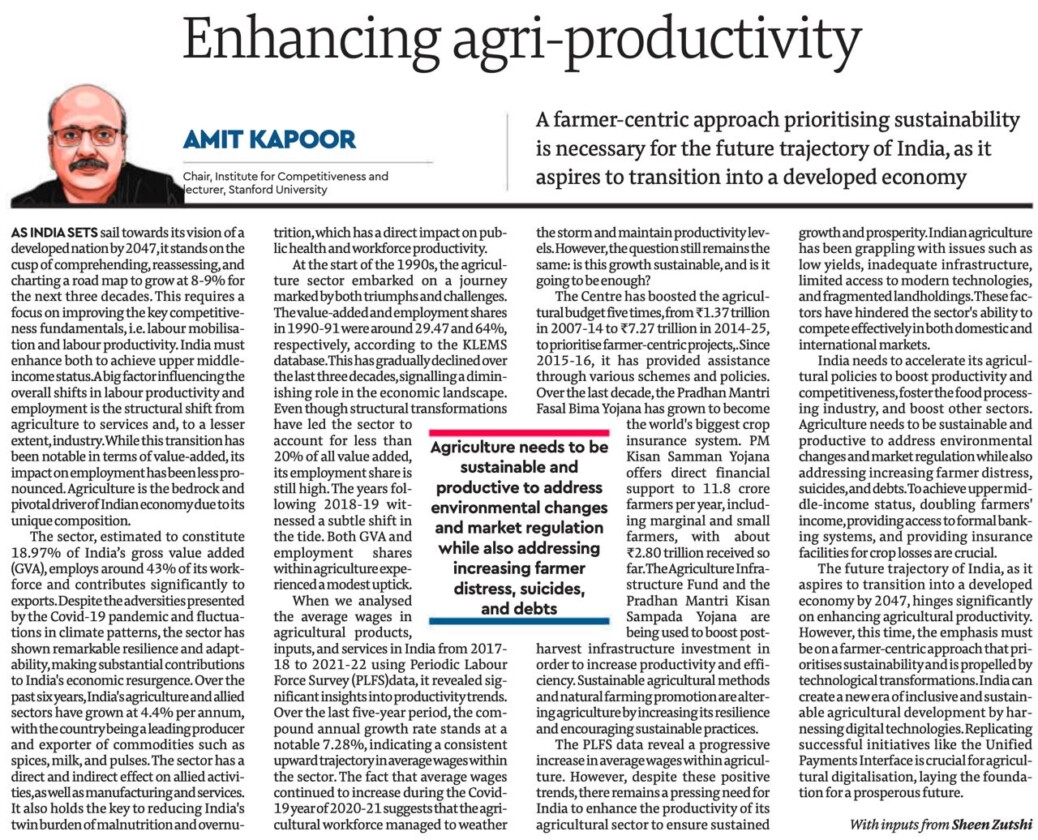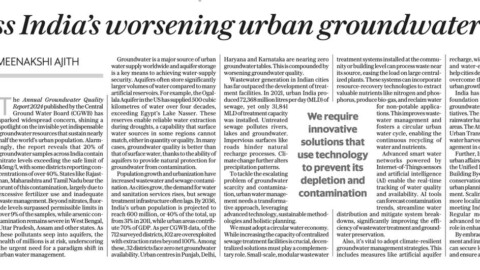Enhancing agri-productivity
As India sets sail towards its vision of a developed nation by 2047, it stands on the cusp of comprehending, reassessing, and charting a road map to grow at 8-9% for the next three decades. This requires a focus on improving the key competitiveness fundamentals, i.e. labour mobilisation and labour productivity. India must enhance both to achieve upper middle-income status. A big factor influencing the overall shifts in labour productivity and employment is the structural shift from agriculture to services and, to a lesser extent, industry. While this transition has been notable in terms of value-added, its impact on employment has been less pronounced. Agriculture is the bedrock and pivotal driver of Indian economy due to its unique composition.
The sector, estimated to constitute 18.97% of India’s gross value added (GVA), employs around 43% of its workforce and contributes significantly to exports. Despite the adversities presented by the Covid-19 pandemic and fluctuations in climate patterns, the sector has shown remarkable resilience and adaptability, making substantial contributions to India’s economic resurgence. Over the past six years, India’s agriculture and allied sectors have grown at 4.4% per annum, with the country being a leading producer and exporter of commodities such as spices, milk, and pulses. The sector has a direct and indirect effect on allied activities, as well as manufacturing and services. It also holds the key to reducing India’s twin burden of malnutrition and overnutrition, which has a direct impact on public health and workforce productivity.
At the start of the 1990s, the agriculture sector embarked on a journey marked by both triumphs and challenges. The value-added and employment shares in 1990-91 were around 29.47 and 64%, respectively, according to the KLEMS database. This has gradually declined over the last three decades, signalling a diminishing role in the economic landscape. Even though structural transformations have led the sector to account for less than 20% of all value added, its employment share is still high. The years following 2018-19 witnessed a subtle shift in the tide. Both GVA and employment shares within agriculture experienced a modest uptick.
When we analysed the average wages in agricultural products, inputs, and services in India from 2017-18 to 2021-22 using Periodic Labour Force Survey (PLFS)data, it revealed significant insights into productivity trends. Over the last five-year period, the compound annual growth rate stands at a notable 7.28%, indicating a consistent upward trajectory in average wages within the sector. The fact that average wages continued to increase during the Covid-19 year of 2020-21 suggests that the agricultural workforce managed to weather the storm and maintain productivity levels. However, the question still remains the same: is this growth sustainable, and is it going to be enough?
The Centre has boosted the agricultural budget five times, from `1.37 trillion in 2007-14 to `7.27 trillion in 2014-25, to prioritise farmer-centric projects,. Since 2015-16, it has provided assistance through various schemes and policies. Over the last decade, the Pradhan Mantri Fasal Bima Yojana has grown to become the world’s biggest crop insurance system. PM Kisan Samman Yojana offers direct financial support to 11.8 crore farmers per year, including marginal and small farmers, with about `2.80 trillion received so far. The Agriculture Infrastructure Fund and the Pradhan Mantri Kisan Sampada Yojana are being used to boost post-harvest infrastructure investment in order to increase productivity and efficiency. Sustainable agricultural methods and natural farming promotion are altering agriculture by increasing its resilience and encouraging sustainable practices.
The PLFS data reveal a progressive increase in average wages within agriculture. However, despite these positive trends, there remains a pressing need for India to enhance the productivity of its agricultural sector to ensure sustained growth and prosperity. Indian agriculture has been grappling with issues such as low yields, inadequate infrastructure, limited access to modern technologies, and fragmented landholdings. These factors have hindered the sector’s ability to compete effectively in both domestic and international markets.
India needs to accelerate its agricultural policies to boost productivity and competitiveness, foster the food processing industry, and boost other sectors. Agriculture needs to be sustainable and productive to address environmental changes and market regulation while also addressing increasing farmer distress, suicides, and debts. To achieve upper middle-income status, doubling farmers’ income, providing access to formal banking systems, and providing insurance facilities for crop losses are crucial.
The future trajectory of India, as it aspires to transition into a developed economy by 2047, hinges significantly on enhancing agricultural productivity. However, this time, the emphasis must be on a farmer-centric approach that prioritises sustainability and is propelled by technological transformations. India can create a new era of inclusive and sustainable agricultural development by harnessing digital technologies. Replicating successful initiatives like the Unified Payments Interface is crucial for agricultural digitalisation, laying the foundation for a prosperous future.
The article was published with Financial Express on May 6, 2024.
























